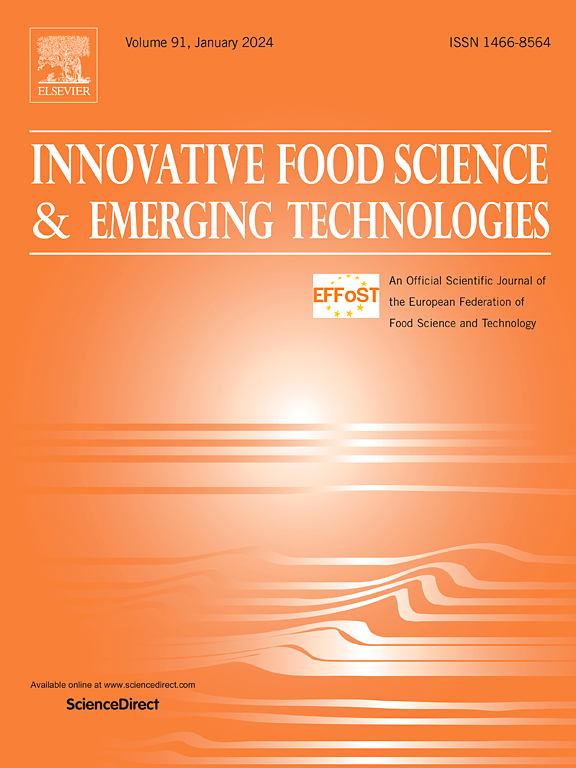Assessing the effect of cold plasma pretreatment on the quality characteristics of bioactive compound extraction from high-pressure processing treated green coffee beans
IF 6.3
1区 农林科学
Q1 FOOD SCIENCE & TECHNOLOGY
Innovative Food Science & Emerging Technologies
Pub Date : 2025-02-27
DOI:10.1016/j.ifset.2025.103978
引用次数: 0
Abstract
This study presents a novel approach for enhancing the extraction efficiency of bioactive compounds from green coffee beans (Coffea arabica) by combining cold plasma pretreatment with high-pressure processing (HPP). Traditional extraction methods often result in the degradation of bioactives and raise environmental concerns. Cold plasma, a non-thermal technology, modifies plant cell walls to increase permeability, facilitating the release of valuable compounds. When integrated with HPP, which uses hydrostatic pressure to further enhance extraction, the combination proves highly effective. Optical Emission Spectroscopy (OES) was used to characterize plasma-generated reactive species interacting with the coffee bean surfaces, improving extraction yield. Significant improvements were observed in total phenolic content (TPC), radical scavenging activity, chlorogenic acid (CGA), and caffeine levels. Notably, the highest extraction yield (16.682 mg/mL) was achieved with 300 MPa HPP for 30 min without cold plasma. Cold plasma pretreatment increased TPC to 18.661 mg/mL (5 min of cold plasma and 300 MPa HPP for 10 min), and radical scavenging activity reached up to 96.845 %. This combined treatment also led to enhanced CGA content
(10.294 mg/mL). The Gas Chromatography-Mass Spectrometry (GC–MS) analysis revealed significant changes in the composition and concentration of secondary metabolites, such as caffeine and phenolic derivatives. Gas Chromatography-Mass Spectrometry (GC–MS) analysis revealed significant changes in the composition and concentration of secondary metabolites, such as caffeine and phenolic derivatives. This study demonstrates the novel and promising potential of cold plasma-assisted HPP for producing high-quality, bioactive-rich extracts from green coffee beans, with considerable advantages over conventional extraction methods in terms of bioactive preservation and extraction efficiency. The approach holds significant potential for applications in the food, beverage, and nutraceutical industries.

评价冷等离子体预处理对高压处理生咖啡豆萃取物质量特性的影响
采用冷等离子体预处理和高压处理相结合的方法,提高了从绿咖啡豆(Coffea arabica)中提取生物活性物质的效率。传统的提取方法往往会导致生物活性的降解,并引起环境问题。冷等离子体是一种非热技术,可以修饰植物细胞壁以增加渗透性,促进有价值化合物的释放。当与HPP(利用静水压力进一步提高萃取效率)结合使用时,这种组合被证明是非常有效的。利用光学发射光谱(OES)来表征等离子体产生的反应物质与咖啡豆表面的相互作用,从而提高萃取率。总酚含量(TPC)、自由基清除活性、绿原酸(CGA)和咖啡因水平均有显著改善。在无冷等离子体条件下,在300 MPa高压条件下提取30 min,提取率最高,为16.682 mg/mL。冷等离子体预处理可使TPC达到18.661 mg/mL(冷等离子体5 min, HPP 300 MPa, 10 min),自由基清除活性达到96.845%。该组合处理还提高了CGA含量(10.294 mg/mL)。气相色谱-质谱(GC-MS)分析显示,次生代谢物(如咖啡因和酚类衍生物)的组成和浓度发生了显著变化。气相色谱-质谱(GC-MS)分析显示,次生代谢物(如咖啡因和酚类衍生物)的组成和浓度发生了显著变化。这项研究表明,冷等离子体辅助HPP技术在从生咖啡豆中提取高质量、富含生物活性的提取物方面具有广阔的潜力,在生物活性保存和提取效率方面比传统的提取方法有很大的优势。该方法在食品、饮料和营养保健工业中具有巨大的应用潜力。
本文章由计算机程序翻译,如有差异,请以英文原文为准。
求助全文
约1分钟内获得全文
求助全文
来源期刊
CiteScore
12.00
自引率
6.10%
发文量
259
审稿时长
25 days
期刊介绍:
Innovative Food Science and Emerging Technologies (IFSET) aims to provide the highest quality original contributions and few, mainly upon invitation, reviews on and highly innovative developments in food science and emerging food process technologies. The significance of the results either for the science community or for industrial R&D groups must be specified. Papers submitted must be of highest scientific quality and only those advancing current scientific knowledge and understanding or with technical relevance will be considered.

 求助内容:
求助内容: 应助结果提醒方式:
应助结果提醒方式:


